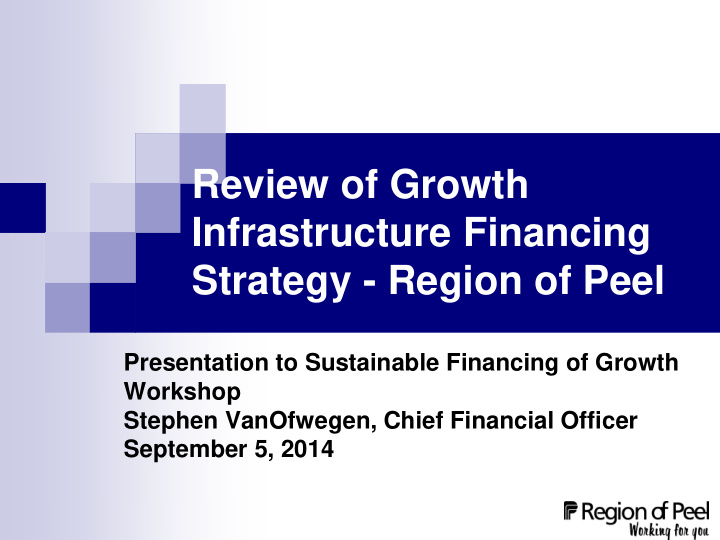



Review of Growth Infrastructure Financing Strategy - Region of Peel Presentation to Sustainable Financing of Growth Workshop Stephen VanOfwegen, Chief Financial Officer September 5, 2014
Outline Maintaining Peel’s Long Term Sustainability Recap Growth Management Committee June 5/July 17, 2014 Current DC Plan Challenges Outline Growth Capital Financing Options Insights regarding financing options and sharing financial risk Next steps 2
Managing Risks to Peel’s Long Term Sustainability Financial Principles Indicator Overall Financial Condition High level credit rating Sustainability Tax rate in line with inflation ■ Respect the tax payer Adequate Capital Reserves - Tax ■ Maintain Assets ■ Ensure Capital Plan is sustainable Adequate Capital Reserves - Utility ■ Deliver value for money Focus GTA Survey - Value for Tax Vulnerability Less than 20% DC rate increase required ■ Users pay where appropriate Less than 50% of Budget funded by property ■ Work with area municipalities to tax support economic viability of the community Non-residential tax revenue - 35% to 45% ■ Prudently invest 100% compliance with investment policy Flexibility Adequate Rate Stabilization Reserves Tax - 5% to 10% ■ Mitigate significant fluctuations in tax Adequate cash to fund 12 month debt and utility rates payments Adequate Rate Stabilization Reserves Utility - ■ Borrow only for substantial long term 5% to 10% assets at affordable rates Annual debt payments <25% own source revenue 3
June 5/July 17 Presentations Recap Presentations to GMC meetings overviewed: Region’s growth financing challenges DC activity/revenues: actual vs. planed Region’s risk re: upfront funding of infrastructure Major cost drivers of DC costs Growth related capital cost recovery methods used elsewhere Potential financing options available to Region 4
Growth Finances - Observations 1. DC revenues occur after capital projects 2. DC revenues not in line with forecasts 3. Existing serviced land not being fully developed 4. Capital costs continue to rise 5
Residential DC Activity Summary 2002 - 2013 Residential Revenue Residential Units 120,000 1,400 $ Millions 100,000 1,200 Units 1,000 80,000 800 60,000 600 40,000 400 20,000 200 - - Forecasted Actual Forecasted Actual 6
Non-Residential DC Activity Summary 2002 - 2013 Non-Residential GFA Non-Residential Revenue 14 900 800 12 $ Millions 700 Square Metres 10 Millions 600 8 500 400 6 300 4 200 2 100 - - Forecasted Actual Forecasted Actual 7
Peel’s Cash Flow Dilemma Development Timing OPA/ Secondary Plan Draft Approval Subdivision Approval Building Permit Post Occupancy Service Capital Item Water: Treatment Distribution Local Wastewater Treatment Collection Local Stormwater Management Facilities Roads and Related Roads Rolling Stock Library Facilities Collection Materials Transit Facilities Vehicles Parking Parking Spaces Police Facilities Vehicles Police Communication Equipment Police Officer Equipment Health Unit Facilities Ambulance Facilities Vehicles Child Care Facilities Provincial Offences Act Facilities Parks Parkland Development Recreation Facilities Fire Facilities Vehicles Firefighter Equipment Administrative Growth Studies 8
Types of Development Charges Act Agreements – Financing Options As noted, most hard infrastructure must be emplaced prior to development proceeding – often require the municipality to upfront costs in anticipation of growth this can be done by collection at subdivision approval or by agreement DCA provides for certain types of agreements to be used to assist in cash flow of these expenditures: Service Emplacement Agreements Accelerated Payment Agreements Front-Ending Agreements 9
Benefit of Collecting DCs at Subdivision Approval Net Outstanding Debt - Actual and Planned Borrowings 2010-2031 1.0 0.5 0.0 -0.5 $ billions -1.0 -1.5 -2.0 $80 – 130 million reduction in borrowing -2.5 -3.0 DC Debt Plan Early DC Revenue Collection - Range Maximum 10
Options to Advance Timing of DC Revenue Generally to initiate some form of agreement requires a reason or inducement, for example: Subdivision approval may be held pending provision of funding of smaller localized projects Secondary plan approval may be held until financial agreements have been entered into Development control though an allocation of water/wastewater capacity (e.g. Halton Region) capacity allocated on a single detached equivalent (SDE) basis which must be obtained or no development approvals may be granted additional prepayment for targeted amount of SDEs required 11
Review of Future Areas of Development 12
Next Steps/Actions Assess cash flow and debt financing implications of financing tools identified (i.e. agreements) Growth Management Committee resolution to start update of DC background study Background study to review DC model assumptions including: Persons per unit (PPU), Floor space per worker (FSW), Housing mix, and others 13
Summary Remarks Peel requires a multi-faceted approach to ensure growth infrastructure financing plan is sustainable Requires cash flow assistance to finance considerable infrastructure costs; consideration include: Accelerate all hard service collections to earliest time possible (i.e. subdivision agreement) Consider negotiated agreements (i.e. prepayment agreements or front-ending) to fund growth projects Will need to consider an approval program (e.g. Allocation Program) and coordinate with area municipalities Review DC model and assumptions are appropriate to ensure growth pays for growth Continued review and management of capital costs 14
Recommend
More recommend